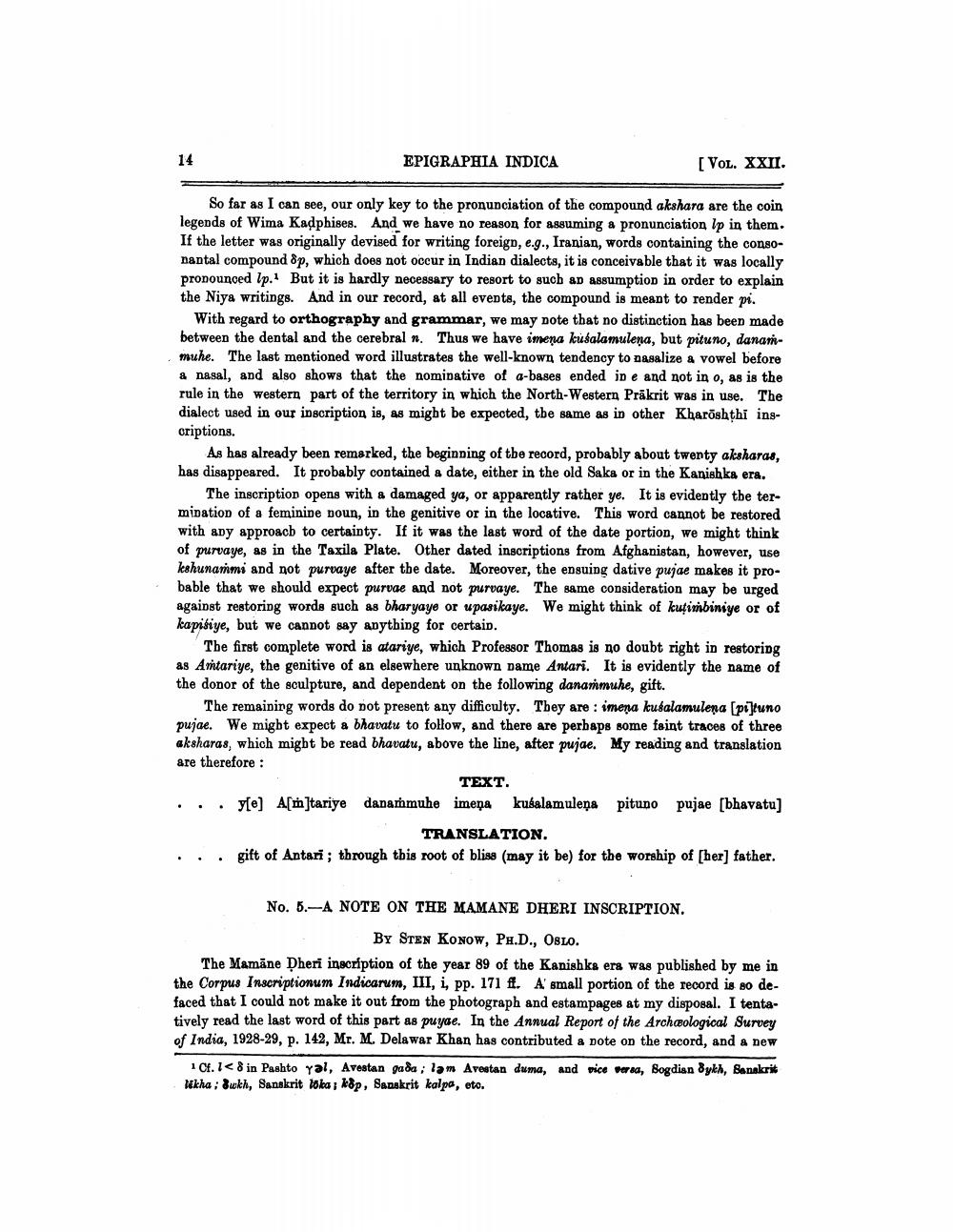________________
EPIGRAPHIA INDICA
[Vol. XXII.
So far as I can see, our only key to the pronunciation of the compound akshara are the coin legends of Wima Kadphises. And we have no reason for assuming a pronunciation Ip in them. If the letter was originally devised for writing foreign, e.g., Iranian, words containing the consonantal compound 8p, which does not occur in Indian dialects, it is conceivable that it was locally pronounced lp. But it is hardly necessary to resort to such an assumption in order to explain the Niya writings. And in our record, at all events, the compound is meant to render pi.
With regard to orthography and grammar, we may note that no distinction has been made between the dental and the cerebral n. Thus we have imena kusalamulena, but pituno, danarmuhe. The last mentioned word illustrates the well-known tendency to nasalize a vowel before & nasal, and also shows that the nominative of a-bases ended in e and not in o, as is the rule in the western part of the territory in which the North-Western Prākrit was in use. The dialect used in our inscription is, as might be expected, the same as in other Kharoshthi inscriptions.
As has already been remarked, the beginning of the record, probably about twenty aksharas, has disappeared. It probably contained a date, either in the old Saka or in the Kanishka era.
The inscription opens with a damaged ya, or apparently rather ye. It is evidently the termination of a feminine poun, in the genitive or in the locative. This word cannot be restored with any approach to certainty. If it was the last word of the date portion, we might think of purvaye, as in the Taxila Plate. Other dated inscriptions from Afghanistan, however, use kshunarmi and not purvaye after the date. Moreover, the ensuing dative pujae makes it probable that we should expect purvae and not purvaye. The same consideration may be urged against restoring words such as bharyaye or upasikaye. We might think of kutimbiniye or of kapisiye, but we cannot say anything for certain.
The first complete word is atariye, which Professor Thomas is no doubt right in restoring as Amtariye, the genitive of an elsewhere unknown dame Antari. It is evidently the name of the donor of the sculpture, and dependent on the following dananmuhe, gift.
The remaining words do not present any difficulty. They are : imena kusalamulena (piltuno pujae. We might expect a bhavatu to follow, and there are perhaps some faint traces of three aksharas, which might be read bhavatu, above the line, after pujae. My reading and translation are therefore :
TEXT. ... y[e] A[m]tariye danammuhe imeņa kusalamuleņa pituno pujae [bhavatu]
TRANSLATION. ... gift of Antari; through this root of bliss (may it be) for the worship of (her) father.
No. 6.-A NOTE ON THE MAMANE DHERI INSCRIPTION.
BY STEN Konow, Ph.D., Oslo. The Mamane Dheri inscription of the year 89 of the Kanishka era was published by me in the Corpus Inscriptionum Indicarum, III, i, pp. 171 ff. A small portion of the record is so defaced that I could not make it out from the photograph and estampages at my disposal. I tentatively read the last word of this part as puyae. In the Annual Report of the Archæological Survey of India, 1928-29, p. 142, Mr. M. Delawar Khan has contributed a pote on the record, and a new
1 Cf. I< 8 in Pashto yal, Avestan gada; lam Avestan duma, and vice versa, Bogdian dykh, Sanskrit Ukha : Sukh, Sanskrit lola; köp, Sanskrit kalpa, eto.




